Closing the Gap Policy and its Impact on Indigenous Health Outcomes
VerifiedAdded on 2022/09/18
|8
|2359
|18
Essay
AI Summary
This essay provides an in-depth analysis of the "Closing the Gap" (CTG) policy, focusing on its impact on Indigenous Australian health outcomes. It begins by explaining the policy's origins, historical context, and the data that prompted its creation, highlighting the health disparities between Indigenous and non-Indigenous populations. The essay then discusses the significance of the CTG policy, examining its influence on life expectancy, access to healthcare, educational opportunities, and employment. The discussion includes the barriers and challenges affecting these changes. A case study of a 57-year-old Aboriginal woman with type 2 diabetes and a leg ulcer is used to analyze the impact of diabetes on social determinants of health, such as unemployment, lack of access to healthcare, and poverty, and how the CTG policy addresses these issues. The essay explores the potential benefits of registering with CTG, including access to low-cost medicines and improved employment prospects. It also defines the roles of Aboriginal Medical Services (AMS) and Aboriginal Liaison Officers (ALOs) in supporting Indigenous patients, explaining how these services assist Judy and her family. The essay concludes by emphasizing the importance of the CTG policy in reducing health disparities and improving the overall well-being of Indigenous Australians.

Running head: INDIGENOUS HEALTH AND WELLBEING
Introduction:
The health imbalances between Indigenous Australian population and non-Indigenous
Australians are well documented in the literature. There is a mountain of evidence present in the
literature which reported that Indigenous Australians are subjected to greater amount morbidity,
mortality and disability compared to the non-indigenous Australian due to disparities in access to
the health care, discrimination, and poverty (Www.humanrights.gov.au 2019). Hence, to reduce
the high discrepancy in opportunities between these two populations, closing the gap policy has
been designed. Close the Gap is considered as a social justice campaign which desires to achieve
health equality between indigenous and the non-indigenous Australian population. Hence, the
paper intended to provide an in-depth analysis of Closing the Gap" policy with the assistance of
a case study where 57 years old lady has type 2 Diabetes and discharged home with a leg ulcer
and prescribed for daily dressings. She was a part-time primary school teacher but due to her
mobility issues has now retired. This paper will discuss the importance of closing the gap
strategy, long term effect of diabetes, impact, and benefit of CGT on the social determinants, the
role of AMS and ALO in following paraphrases.
Discussion:
Closing the gap and significance:
Closing the Gap is a government policy which intended to lower the gap between
Indigenous Australian and the non – indigenous Australian in terms of life expectancy, access to
health care, educational opportunities and the employment opportunities (Fisher et al. 2016). It is
Introduction:
The health imbalances between Indigenous Australian population and non-Indigenous
Australians are well documented in the literature. There is a mountain of evidence present in the
literature which reported that Indigenous Australians are subjected to greater amount morbidity,
mortality and disability compared to the non-indigenous Australian due to disparities in access to
the health care, discrimination, and poverty (Www.humanrights.gov.au 2019). Hence, to reduce
the high discrepancy in opportunities between these two populations, closing the gap policy has
been designed. Close the Gap is considered as a social justice campaign which desires to achieve
health equality between indigenous and the non-indigenous Australian population. Hence, the
paper intended to provide an in-depth analysis of Closing the Gap" policy with the assistance of
a case study where 57 years old lady has type 2 Diabetes and discharged home with a leg ulcer
and prescribed for daily dressings. She was a part-time primary school teacher but due to her
mobility issues has now retired. This paper will discuss the importance of closing the gap
strategy, long term effect of diabetes, impact, and benefit of CGT on the social determinants, the
role of AMS and ALO in following paraphrases.
Discussion:
Closing the gap and significance:
Closing the Gap is a government policy which intended to lower the gap between
Indigenous Australian and the non – indigenous Australian in terms of life expectancy, access to
health care, educational opportunities and the employment opportunities (Fisher et al. 2016). It is
Paraphrase This Document
Need a fresh take? Get an instant paraphrase of this document with our AI Paraphraser
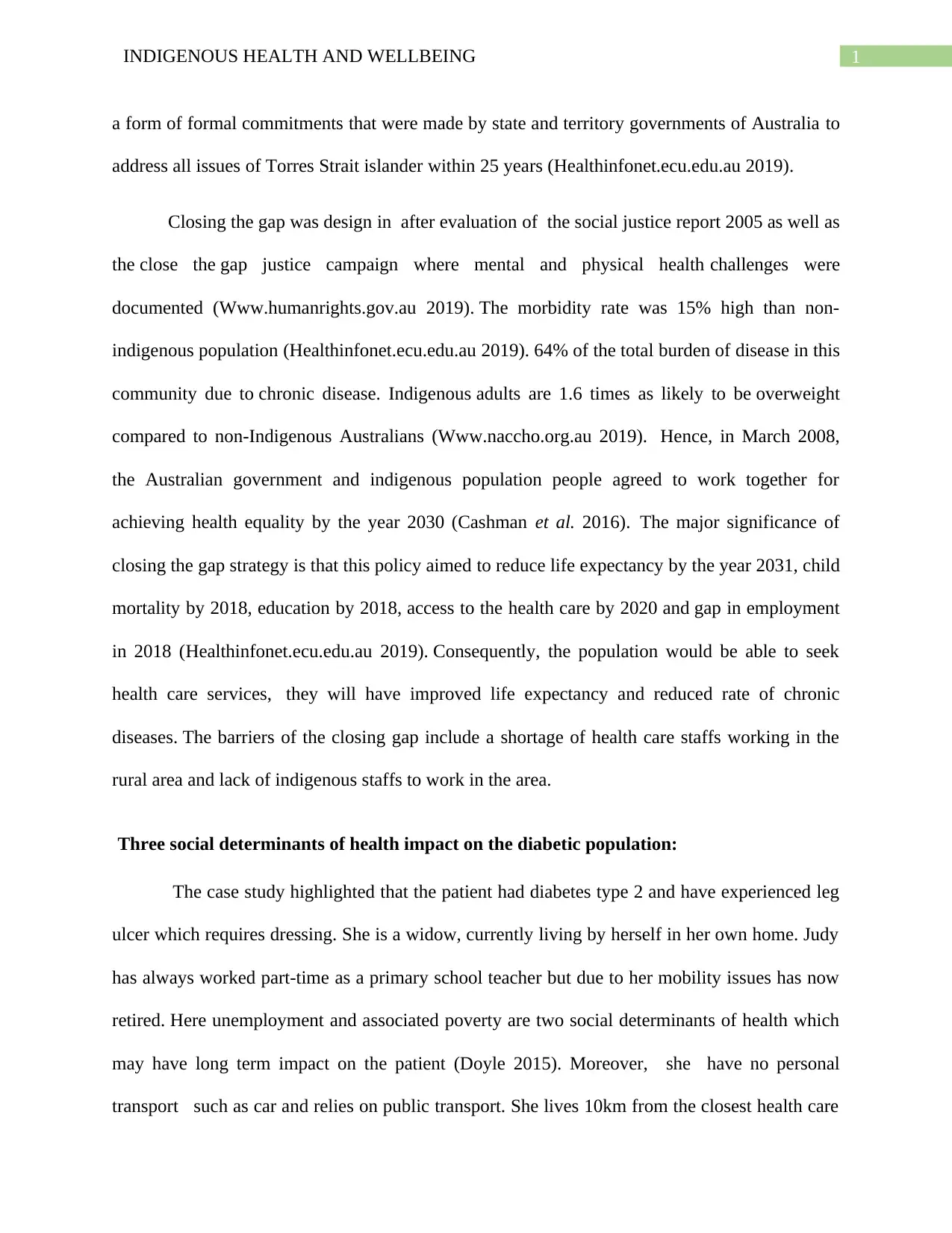
1INDIGENOUS HEALTH AND WELLBEING
a form of formal commitments that were made by state and territory governments of Australia to
address all issues of Torres Strait islander within 25 years (Healthinfonet.ecu.edu.au 2019).
Closing the gap was design in after evaluation of the social justice report 2005 as well as
the close the gap justice campaign where mental and physical health challenges were
documented (Www.humanrights.gov.au 2019). The morbidity rate was 15% high than non-
indigenous population (Healthinfonet.ecu.edu.au 2019). 64% of the total burden of disease in this
community due to chronic disease. Indigenous adults are 1.6 times as likely to be overweight
compared to non-Indigenous Australians (Www.naccho.org.au 2019). Hence, in March 2008,
the Australian government and indigenous population people agreed to work together for
achieving health equality by the year 2030 (Cashman et al. 2016). The major significance of
closing the gap strategy is that this policy aimed to reduce life expectancy by the year 2031, child
mortality by 2018, education by 2018, access to the health care by 2020 and gap in employment
in 2018 (Healthinfonet.ecu.edu.au 2019). Consequently, the population would be able to seek
health care services, they will have improved life expectancy and reduced rate of chronic
diseases. The barriers of the closing gap include a shortage of health care staffs working in the
rural area and lack of indigenous staffs to work in the area.
Three social determinants of health impact on the diabetic population:
The case study highlighted that the patient had diabetes type 2 and have experienced leg
ulcer which requires dressing. She is a widow, currently living by herself in her own home. Judy
has always worked part-time as a primary school teacher but due to her mobility issues has now
retired. Here unemployment and associated poverty are two social determinants of health which
may have long term impact on the patient (Doyle 2015). Moreover, she have no personal
transport such as car and relies on public transport. She lives 10km from the closest health care
a form of formal commitments that were made by state and territory governments of Australia to
address all issues of Torres Strait islander within 25 years (Healthinfonet.ecu.edu.au 2019).
Closing the gap was design in after evaluation of the social justice report 2005 as well as
the close the gap justice campaign where mental and physical health challenges were
documented (Www.humanrights.gov.au 2019). The morbidity rate was 15% high than non-
indigenous population (Healthinfonet.ecu.edu.au 2019). 64% of the total burden of disease in this
community due to chronic disease. Indigenous adults are 1.6 times as likely to be overweight
compared to non-Indigenous Australians (Www.naccho.org.au 2019). Hence, in March 2008,
the Australian government and indigenous population people agreed to work together for
achieving health equality by the year 2030 (Cashman et al. 2016). The major significance of
closing the gap strategy is that this policy aimed to reduce life expectancy by the year 2031, child
mortality by 2018, education by 2018, access to the health care by 2020 and gap in employment
in 2018 (Healthinfonet.ecu.edu.au 2019). Consequently, the population would be able to seek
health care services, they will have improved life expectancy and reduced rate of chronic
diseases. The barriers of the closing gap include a shortage of health care staffs working in the
rural area and lack of indigenous staffs to work in the area.
Three social determinants of health impact on the diabetic population:
The case study highlighted that the patient had diabetes type 2 and have experienced leg
ulcer which requires dressing. She is a widow, currently living by herself in her own home. Judy
has always worked part-time as a primary school teacher but due to her mobility issues has now
retired. Here unemployment and associated poverty are two social determinants of health which
may have long term impact on the patient (Doyle 2015). Moreover, she have no personal
transport such as car and relies on public transport. She lives 10km from the closest health care

2INDIGENOUS HEALTH AND WELLBEING
facility. In this case, the third-social determinants of health are lack of access to health care.
The closing gap the strategies can address these three social determinants of health by 2030
(Fisher et al. 2016). The closing the gap provide an opportunity to
intensive employment services to Indigenous job seekers. In this case, after registration, she may
have an opportunity to work as a part-time teacher. Moreover, to address the poverty, the policy
provided financial facilities to the aboriginal individuals who live alone and in this case,
the patient may receive financial support from the government (Finizio 2018). To address the
access to health care, closing the gap provides access through increase inequitable distribution of
Community control of primary health care services such as proper housing, water, and sanitation.
The policy also offers transportation.
Discuss the potential benefits and impact of being registered:
Aboriginal and Torres trait islanders who are living with chronic disease have right to
use the low cost or free pharmaceutical benefits scheme (PBS) medicines through closing the gap
(Ferguson et al. 2018). In this context, registration in the closing the gap policy will address all
of the issues experienced by the patient.
Considering the strategy for unemployment, employment opportunity such as work as a
teacher in the nearby community will address the issues associated with poverty and improve her
wellbeing. Fisher et al. (2016), highlighted the impact of employment is that she would be able
to feel empowered and independent where she had to depend on her son before. She would be
able to seek desired medical services at a low cost through proper transportation and even able to
buy her transport (Smith et al. 2016). Considering the strategy for poverty, she would be able to
facility. In this case, the third-social determinants of health are lack of access to health care.
The closing gap the strategies can address these three social determinants of health by 2030
(Fisher et al. 2016). The closing the gap provide an opportunity to
intensive employment services to Indigenous job seekers. In this case, after registration, she may
have an opportunity to work as a part-time teacher. Moreover, to address the poverty, the policy
provided financial facilities to the aboriginal individuals who live alone and in this case,
the patient may receive financial support from the government (Finizio 2018). To address the
access to health care, closing the gap provides access through increase inequitable distribution of
Community control of primary health care services such as proper housing, water, and sanitation.
The policy also offers transportation.
Discuss the potential benefits and impact of being registered:
Aboriginal and Torres trait islanders who are living with chronic disease have right to
use the low cost or free pharmaceutical benefits scheme (PBS) medicines through closing the gap
(Ferguson et al. 2018). In this context, registration in the closing the gap policy will address all
of the issues experienced by the patient.
Considering the strategy for unemployment, employment opportunity such as work as a
teacher in the nearby community will address the issues associated with poverty and improve her
wellbeing. Fisher et al. (2016), highlighted the impact of employment is that she would be able
to feel empowered and independent where she had to depend on her son before. She would be
able to seek desired medical services at a low cost through proper transportation and even able to
buy her transport (Smith et al. 2016). Considering the strategy for poverty, she would be able to
⊘ This is a preview!⊘
Do you want full access?
Subscribe today to unlock all pages.

Trusted by 1+ million students worldwide
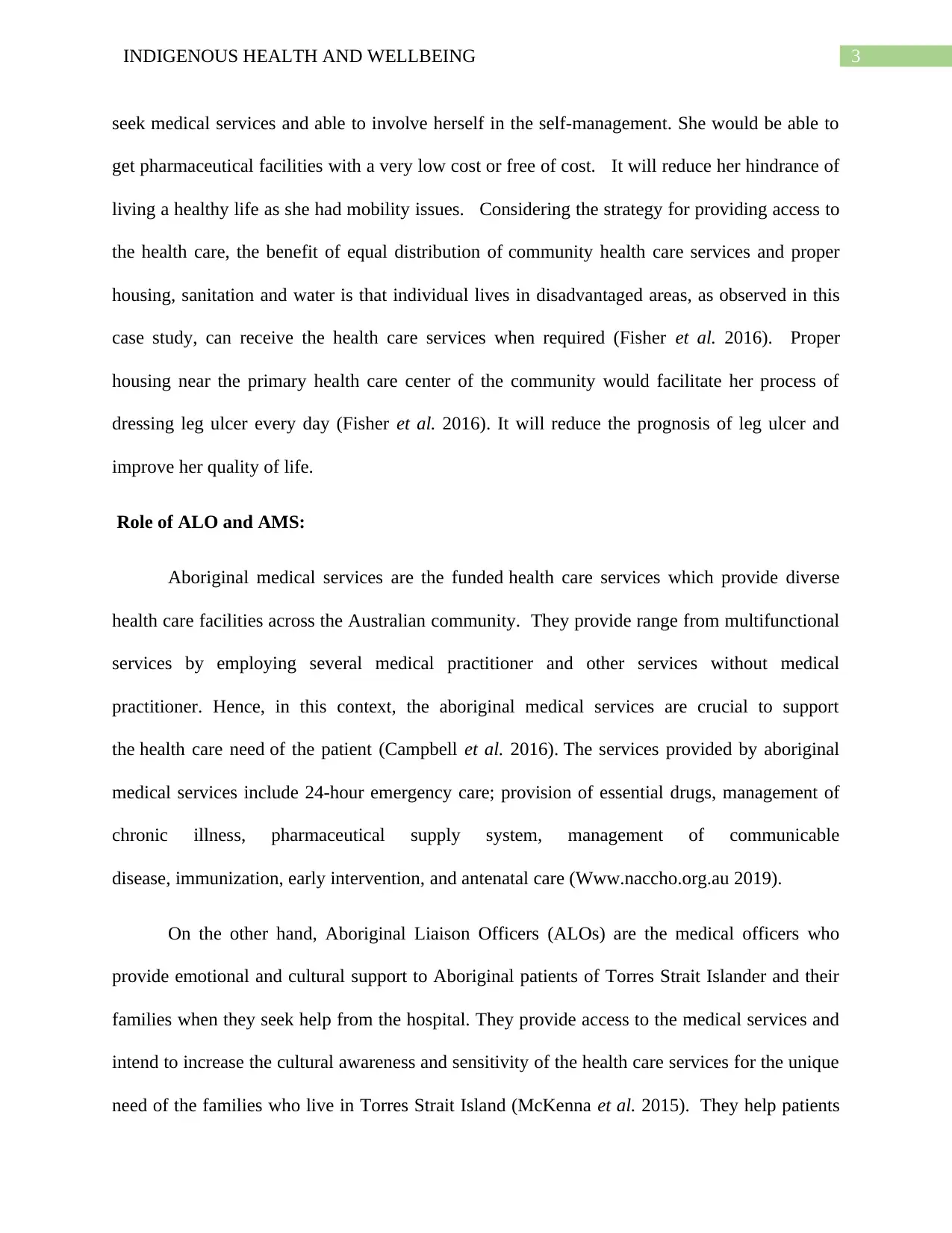
3INDIGENOUS HEALTH AND WELLBEING
seek medical services and able to involve herself in the self-management. She would be able to
get pharmaceutical facilities with a very low cost or free of cost. It will reduce her hindrance of
living a healthy life as she had mobility issues. Considering the strategy for providing access to
the health care, the benefit of equal distribution of community health care services and proper
housing, sanitation and water is that individual lives in disadvantaged areas, as observed in this
case study, can receive the health care services when required (Fisher et al. 2016). Proper
housing near the primary health care center of the community would facilitate her process of
dressing leg ulcer every day (Fisher et al. 2016). It will reduce the prognosis of leg ulcer and
improve her quality of life.
Role of ALO and AMS:
Aboriginal medical services are the funded health care services which provide diverse
health care facilities across the Australian community. They provide range from multifunctional
services by employing several medical practitioner and other services without medical
practitioner. Hence, in this context, the aboriginal medical services are crucial to support
the health care need of the patient (Campbell et al. 2016). The services provided by aboriginal
medical services include 24-hour emergency care; provision of essential drugs, management of
chronic illness, pharmaceutical supply system, management of communicable
disease, immunization, early intervention, and antenatal care (Www.naccho.org.au 2019).
On the other hand, Aboriginal Liaison Officers (ALOs) are the medical officers who
provide emotional and cultural support to Aboriginal patients of Torres Strait Islander and their
families when they seek help from the hospital. They provide access to the medical services and
intend to increase the cultural awareness and sensitivity of the health care services for the unique
need of the families who live in Torres Strait Island (McKenna et al. 2015). They help patients
seek medical services and able to involve herself in the self-management. She would be able to
get pharmaceutical facilities with a very low cost or free of cost. It will reduce her hindrance of
living a healthy life as she had mobility issues. Considering the strategy for providing access to
the health care, the benefit of equal distribution of community health care services and proper
housing, sanitation and water is that individual lives in disadvantaged areas, as observed in this
case study, can receive the health care services when required (Fisher et al. 2016). Proper
housing near the primary health care center of the community would facilitate her process of
dressing leg ulcer every day (Fisher et al. 2016). It will reduce the prognosis of leg ulcer and
improve her quality of life.
Role of ALO and AMS:
Aboriginal medical services are the funded health care services which provide diverse
health care facilities across the Australian community. They provide range from multifunctional
services by employing several medical practitioner and other services without medical
practitioner. Hence, in this context, the aboriginal medical services are crucial to support
the health care need of the patient (Campbell et al. 2016). The services provided by aboriginal
medical services include 24-hour emergency care; provision of essential drugs, management of
chronic illness, pharmaceutical supply system, management of communicable
disease, immunization, early intervention, and antenatal care (Www.naccho.org.au 2019).
On the other hand, Aboriginal Liaison Officers (ALOs) are the medical officers who
provide emotional and cultural support to Aboriginal patients of Torres Strait Islander and their
families when they seek help from the hospital. They provide access to the medical services and
intend to increase the cultural awareness and sensitivity of the health care services for the unique
need of the families who live in Torres Strait Island (McKenna et al. 2015). They help patients
Paraphrase This Document
Need a fresh take? Get an instant paraphrase of this document with our AI Paraphraser
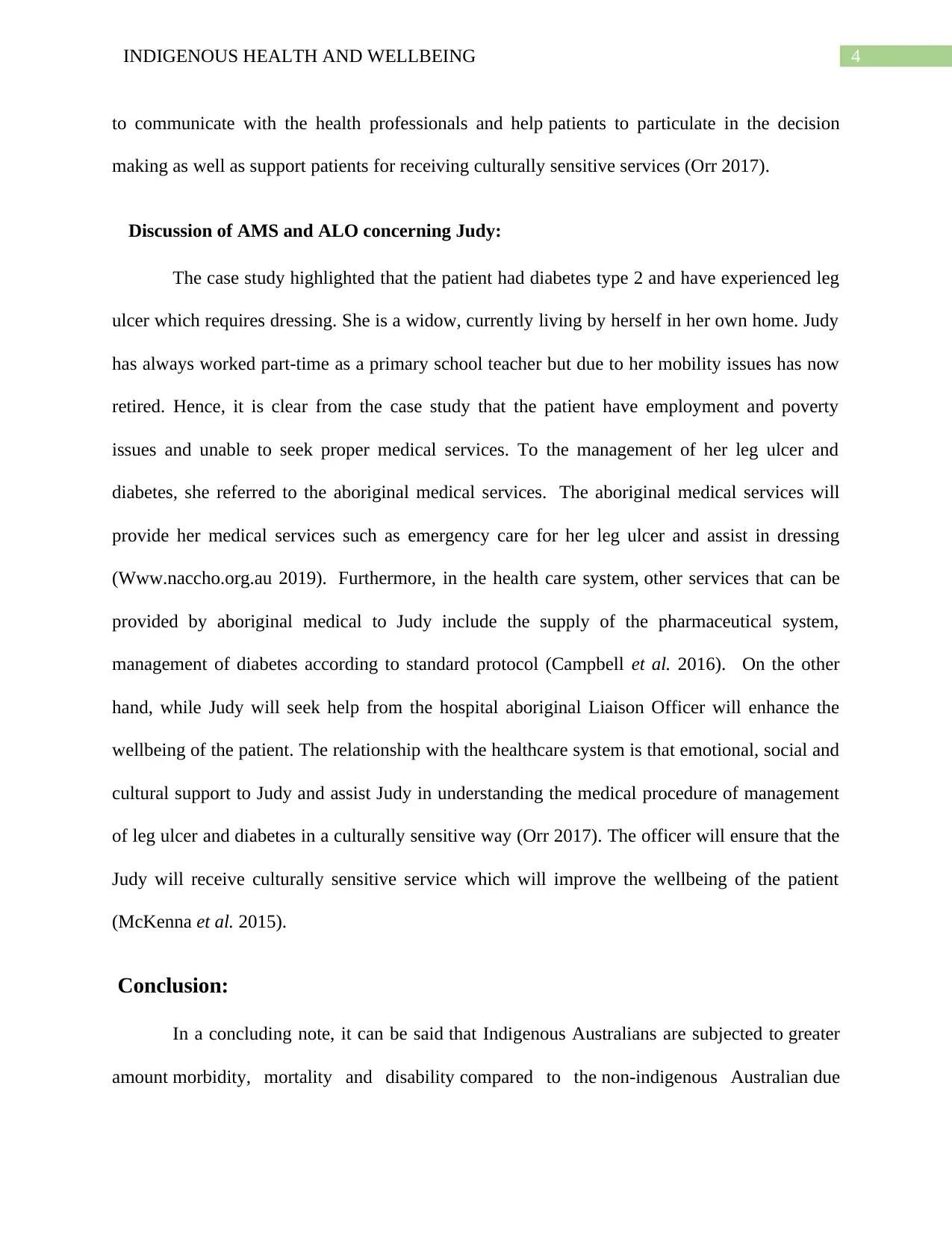
4INDIGENOUS HEALTH AND WELLBEING
to communicate with the health professionals and help patients to particulate in the decision
making as well as support patients for receiving culturally sensitive services (Orr 2017).
Discussion of AMS and ALO concerning Judy:
The case study highlighted that the patient had diabetes type 2 and have experienced leg
ulcer which requires dressing. She is a widow, currently living by herself in her own home. Judy
has always worked part-time as a primary school teacher but due to her mobility issues has now
retired. Hence, it is clear from the case study that the patient have employment and poverty
issues and unable to seek proper medical services. To the management of her leg ulcer and
diabetes, she referred to the aboriginal medical services. The aboriginal medical services will
provide her medical services such as emergency care for her leg ulcer and assist in dressing
(Www.naccho.org.au 2019). Furthermore, in the health care system, other services that can be
provided by aboriginal medical to Judy include the supply of the pharmaceutical system,
management of diabetes according to standard protocol (Campbell et al. 2016). On the other
hand, while Judy will seek help from the hospital aboriginal Liaison Officer will enhance the
wellbeing of the patient. The relationship with the healthcare system is that emotional, social and
cultural support to Judy and assist Judy in understanding the medical procedure of management
of leg ulcer and diabetes in a culturally sensitive way (Orr 2017). The officer will ensure that the
Judy will receive culturally sensitive service which will improve the wellbeing of the patient
(McKenna et al. 2015).
Conclusion:
In a concluding note, it can be said that Indigenous Australians are subjected to greater
amount morbidity, mortality and disability compared to the non-indigenous Australian due
to communicate with the health professionals and help patients to particulate in the decision
making as well as support patients for receiving culturally sensitive services (Orr 2017).
Discussion of AMS and ALO concerning Judy:
The case study highlighted that the patient had diabetes type 2 and have experienced leg
ulcer which requires dressing. She is a widow, currently living by herself in her own home. Judy
has always worked part-time as a primary school teacher but due to her mobility issues has now
retired. Hence, it is clear from the case study that the patient have employment and poverty
issues and unable to seek proper medical services. To the management of her leg ulcer and
diabetes, she referred to the aboriginal medical services. The aboriginal medical services will
provide her medical services such as emergency care for her leg ulcer and assist in dressing
(Www.naccho.org.au 2019). Furthermore, in the health care system, other services that can be
provided by aboriginal medical to Judy include the supply of the pharmaceutical system,
management of diabetes according to standard protocol (Campbell et al. 2016). On the other
hand, while Judy will seek help from the hospital aboriginal Liaison Officer will enhance the
wellbeing of the patient. The relationship with the healthcare system is that emotional, social and
cultural support to Judy and assist Judy in understanding the medical procedure of management
of leg ulcer and diabetes in a culturally sensitive way (Orr 2017). The officer will ensure that the
Judy will receive culturally sensitive service which will improve the wellbeing of the patient
(McKenna et al. 2015).
Conclusion:
In a concluding note, it can be said that Indigenous Australians are subjected to greater
amount morbidity, mortality and disability compared to the non-indigenous Australian due
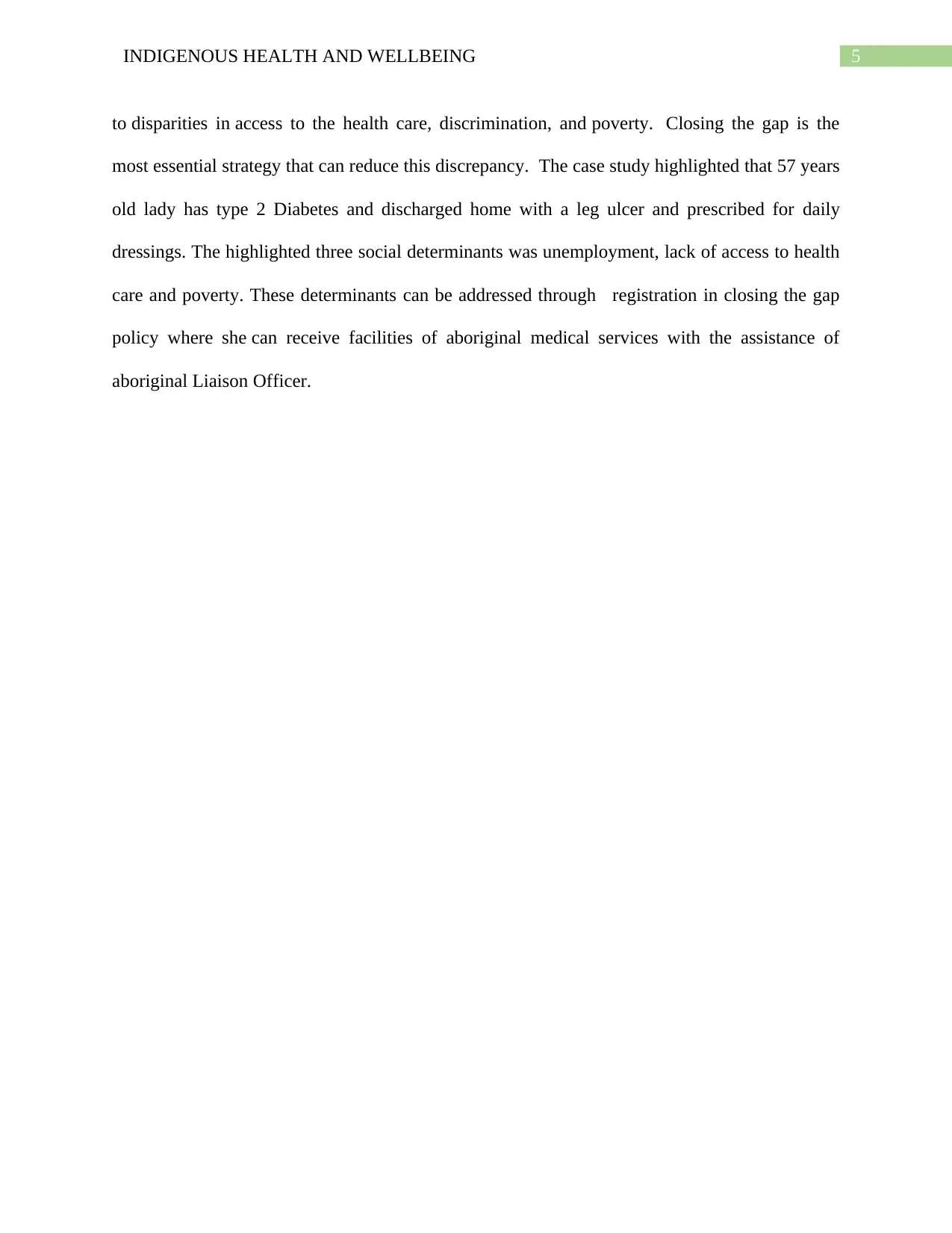
5INDIGENOUS HEALTH AND WELLBEING
to disparities in access to the health care, discrimination, and poverty. Closing the gap is the
most essential strategy that can reduce this discrepancy. The case study highlighted that 57 years
old lady has type 2 Diabetes and discharged home with a leg ulcer and prescribed for daily
dressings. The highlighted three social determinants was unemployment, lack of access to health
care and poverty. These determinants can be addressed through registration in closing the gap
policy where she can receive facilities of aboriginal medical services with the assistance of
aboriginal Liaison Officer.
to disparities in access to the health care, discrimination, and poverty. Closing the gap is the
most essential strategy that can reduce this discrepancy. The case study highlighted that 57 years
old lady has type 2 Diabetes and discharged home with a leg ulcer and prescribed for daily
dressings. The highlighted three social determinants was unemployment, lack of access to health
care and poverty. These determinants can be addressed through registration in closing the gap
policy where she can receive facilities of aboriginal medical services with the assistance of
aboriginal Liaison Officer.
⊘ This is a preview!⊘
Do you want full access?
Subscribe today to unlock all pages.

Trusted by 1+ million students worldwide

6INDIGENOUS HEALTH AND WELLBEING
References:
Campbell, M.A., Hunt, J., Scrimgeour, D.J., Davey, M. and Jones, V., 2018. Contribution of
Aboriginal Community-Controlled Health Services to improving Aboriginal health: an evidence
review. Australian health review, 42(2), pp.218-226.
Cashman, P.M., Allan, N.A., Clark, K.K., Butler, M.T., Massey, P.D. and Durrheim, D.N., 2016.
Closing the gap in Australian Aboriginal infant immunisation rates--the development and review
of a pre-call strategy. BMC public health, 16(1), p.514.
Doyle, K.E., 2015. Australian Aboriginal peoples and evidence-based policies: closing the gap in
social interventions. Journal of evidence-informed social work, 12(2), pp.166-174.
Ferguson, M., O'dea, K., Altman, J., Moodie, M. and Brimblecombe, J., 2018. Health-promoting
food pricing policies and decision-making in very remote Aboriginal and Torres Strait Islander
community stores in Australia. International journal of environmental research and public
health, 15(12), p.2908.
Finizio, A., 2018. Aboriginal justice: The true cost of aboriginal incarceration-the case for justice
reinvestment. Bulletin (Law Society of South Australia), 40(4), p.22.
Fisher, M., Battams, S., Mcdermott, D., Baum, F. and Macdougall, C., 2019. How the social
determinants of Indigenous health became policy reality for Australia's National Aboriginal and
Torres Strait Islander Health Plan. Journal of Social Policy, 48(1), pp.169-189.
Fisher, M., Baum, F.E., MacDougall, C., Newman, L. and McDermott, D., 2016. To what extent
do Australian health policy documents address social determinants of health and health
equity?. Journal of Social Policy, 45(3), pp.545-564.
References:
Campbell, M.A., Hunt, J., Scrimgeour, D.J., Davey, M. and Jones, V., 2018. Contribution of
Aboriginal Community-Controlled Health Services to improving Aboriginal health: an evidence
review. Australian health review, 42(2), pp.218-226.
Cashman, P.M., Allan, N.A., Clark, K.K., Butler, M.T., Massey, P.D. and Durrheim, D.N., 2016.
Closing the gap in Australian Aboriginal infant immunisation rates--the development and review
of a pre-call strategy. BMC public health, 16(1), p.514.
Doyle, K.E., 2015. Australian Aboriginal peoples and evidence-based policies: closing the gap in
social interventions. Journal of evidence-informed social work, 12(2), pp.166-174.
Ferguson, M., O'dea, K., Altman, J., Moodie, M. and Brimblecombe, J., 2018. Health-promoting
food pricing policies and decision-making in very remote Aboriginal and Torres Strait Islander
community stores in Australia. International journal of environmental research and public
health, 15(12), p.2908.
Finizio, A., 2018. Aboriginal justice: The true cost of aboriginal incarceration-the case for justice
reinvestment. Bulletin (Law Society of South Australia), 40(4), p.22.
Fisher, M., Battams, S., Mcdermott, D., Baum, F. and Macdougall, C., 2019. How the social
determinants of Indigenous health became policy reality for Australia's National Aboriginal and
Torres Strait Islander Health Plan. Journal of Social Policy, 48(1), pp.169-189.
Fisher, M., Baum, F.E., MacDougall, C., Newman, L. and McDermott, D., 2016. To what extent
do Australian health policy documents address social determinants of health and health
equity?. Journal of Social Policy, 45(3), pp.545-564.
Paraphrase This Document
Need a fresh take? Get an instant paraphrase of this document with our AI Paraphraser
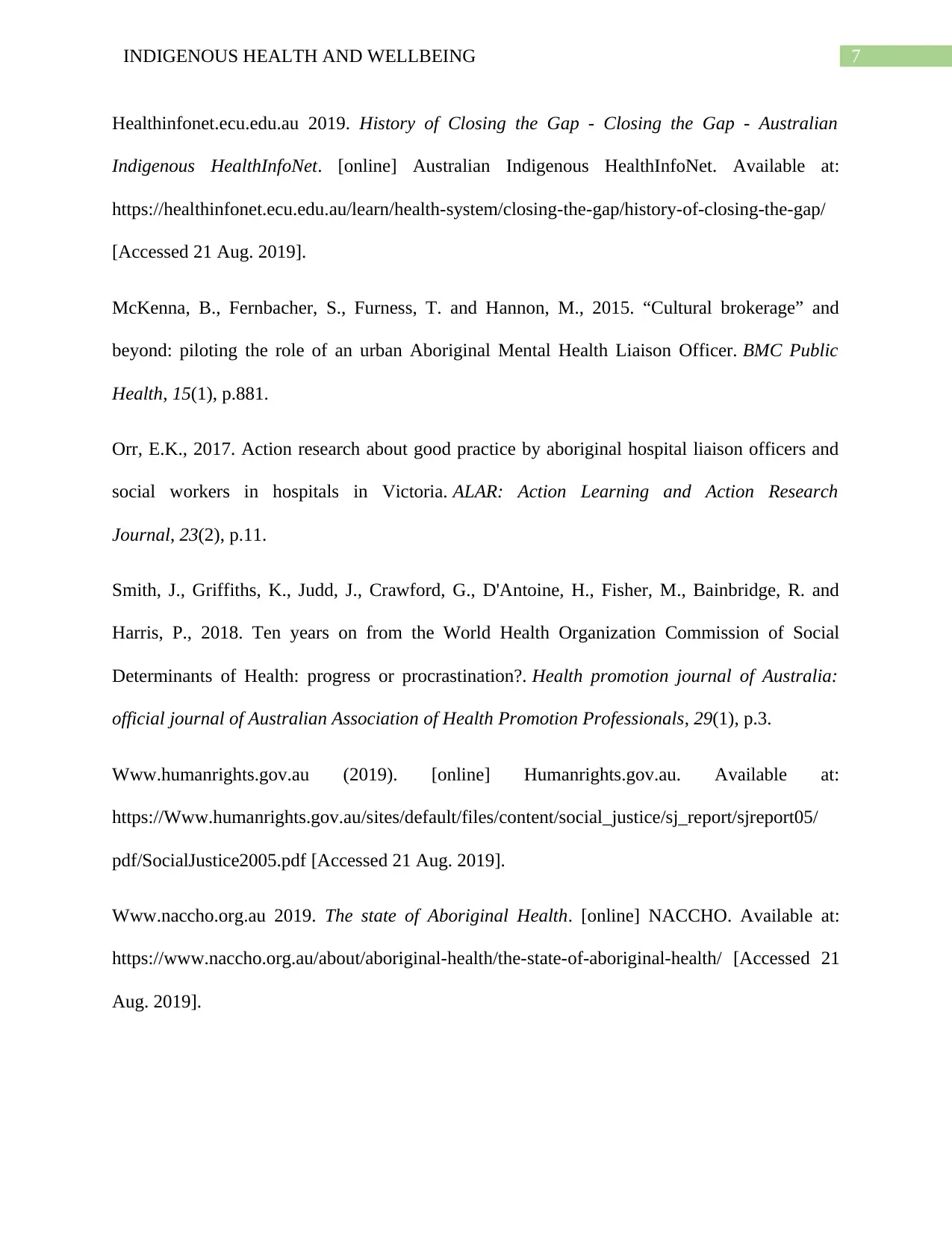
7INDIGENOUS HEALTH AND WELLBEING
Healthinfonet.ecu.edu.au 2019. History of Closing the Gap - Closing the Gap - Australian
Indigenous HealthInfoNet. [online] Australian Indigenous HealthInfoNet. Available at:
https://healthinfonet.ecu.edu.au/learn/health-system/closing-the-gap/history-of-closing-the-gap/
[Accessed 21 Aug. 2019].
McKenna, B., Fernbacher, S., Furness, T. and Hannon, M., 2015. “Cultural brokerage” and
beyond: piloting the role of an urban Aboriginal Mental Health Liaison Officer. BMC Public
Health, 15(1), p.881.
Orr, E.K., 2017. Action research about good practice by aboriginal hospital liaison officers and
social workers in hospitals in Victoria. ALAR: Action Learning and Action Research
Journal, 23(2), p.11.
Smith, J., Griffiths, K., Judd, J., Crawford, G., D'Antoine, H., Fisher, M., Bainbridge, R. and
Harris, P., 2018. Ten years on from the World Health Organization Commission of Social
Determinants of Health: progress or procrastination?. Health promotion journal of Australia:
official journal of Australian Association of Health Promotion Professionals, 29(1), p.3.
Www.humanrights.gov.au (2019). [online] Humanrights.gov.au. Available at:
https://Www.humanrights.gov.au/sites/default/files/content/social_justice/sj_report/sjreport05/
pdf/SocialJustice2005.pdf [Accessed 21 Aug. 2019].
Www.naccho.org.au 2019. The state of Aboriginal Health. [online] NACCHO. Available at:
https://www.naccho.org.au/about/aboriginal-health/the-state-of-aboriginal-health/ [Accessed 21
Aug. 2019].
Healthinfonet.ecu.edu.au 2019. History of Closing the Gap - Closing the Gap - Australian
Indigenous HealthInfoNet. [online] Australian Indigenous HealthInfoNet. Available at:
https://healthinfonet.ecu.edu.au/learn/health-system/closing-the-gap/history-of-closing-the-gap/
[Accessed 21 Aug. 2019].
McKenna, B., Fernbacher, S., Furness, T. and Hannon, M., 2015. “Cultural brokerage” and
beyond: piloting the role of an urban Aboriginal Mental Health Liaison Officer. BMC Public
Health, 15(1), p.881.
Orr, E.K., 2017. Action research about good practice by aboriginal hospital liaison officers and
social workers in hospitals in Victoria. ALAR: Action Learning and Action Research
Journal, 23(2), p.11.
Smith, J., Griffiths, K., Judd, J., Crawford, G., D'Antoine, H., Fisher, M., Bainbridge, R. and
Harris, P., 2018. Ten years on from the World Health Organization Commission of Social
Determinants of Health: progress or procrastination?. Health promotion journal of Australia:
official journal of Australian Association of Health Promotion Professionals, 29(1), p.3.
Www.humanrights.gov.au (2019). [online] Humanrights.gov.au. Available at:
https://Www.humanrights.gov.au/sites/default/files/content/social_justice/sj_report/sjreport05/
pdf/SocialJustice2005.pdf [Accessed 21 Aug. 2019].
Www.naccho.org.au 2019. The state of Aboriginal Health. [online] NACCHO. Available at:
https://www.naccho.org.au/about/aboriginal-health/the-state-of-aboriginal-health/ [Accessed 21
Aug. 2019].
1 out of 8
Related Documents
Your All-in-One AI-Powered Toolkit for Academic Success.
+13062052269
info@desklib.com
Available 24*7 on WhatsApp / Email
![[object Object]](/_next/static/media/star-bottom.7253800d.svg)
Unlock your academic potential
Copyright © 2020–2025 A2Z Services. All Rights Reserved. Developed and managed by ZUCOL.





